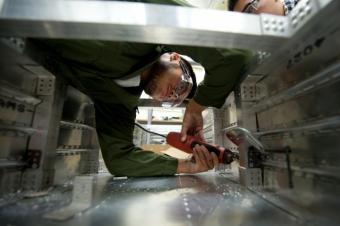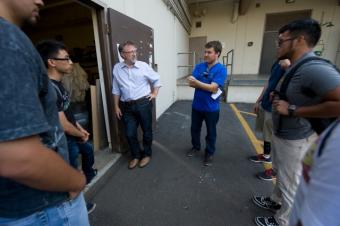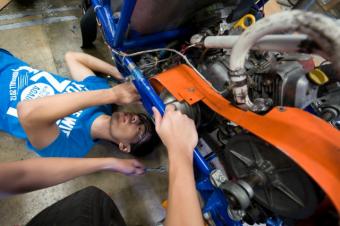On track for clean energy
UCI will host – and compete in – the California Challenge, which pits alternative-fuel race cars against each other
 On the bottom floor of UC Irvine’s Engineering Tower sits the secret weapon – maybe. Dubbed Gamma Prime, it looks like do-it-yourself shelving laid flat. But on this hot August afternoon, it holds the dreams of mechanical engineering professor J. Michael McCarthy’s race-car class.
On the bottom floor of UC Irvine’s Engineering Tower sits the secret weapon – maybe. Dubbed Gamma Prime, it looks like do-it-yourself shelving laid flat. But on this hot August afternoon, it holds the dreams of mechanical engineering professor J. Michael McCarthy’s race-car class.
It’s a long shot, says engineering student Jairus Racelis, 21, but with its ultralightweight aluminum body modeled on fighter jets, Gamma Prime could take the top prize at the first-ever California Challenge. For this national “green car” competition, student teams design and build vehicles with a deceptively simple aim: to see which can go the farthest in an hour on one dollar’s worth of any fuel.
“It’s a great technology; the metal is super light, which means it will be extremely energy-efficient – if we can get it built in time,” Racelis says. He and his teammates hunch over the chassis, welding on precisely machined control arms that will hold the car’s slick rubber wheels. The clock is ticking – six weeks to the starting line.
~
The U.S. Department of Energy asked UC Irvine to stage the race as part of the new XPO clean energy exhibition, an extension of its popular Solar Decathlon. That event invites U.S. and international collegiate teams to design, build and operate efficient and attractive solar houses. Similarly, teams from high schools and colleges across California, plus winners of a Washington, D.C.-based electrathon, will compete in the California Challenge. Like the Solar Decathlon, the aim is to give students who take advanced theory classes hands-on experience.
“The California Challenge will help us extend the clean-energy learning experience beyond the house to the driveway,” says Solar Decathlon director Richard King. “We want to connect budding automotive engineers with their contemporaries in the architecture and construction fields. These young minds will need to work together in the future to design houses that can support alternative-fuel vehicles.”
Building fuel-efficient race cars also gives students practical knowledge valued in the job market.
“The top science and math students come to UCI, but some of them don’t know how to use a wrench when they get here,” says McCarthy, director of the California Challenge. “I tell them, ‘You’ve taken the class, but this is what’s going to get you a job: You built a car.’”
Last year, his graduates landed engineering jobs at such automotive companies as Behrens and SnapOn. A dozen stalwarts in this year’s senior class spent the summer working on five cars for the California Challenge. They were joined by 50 more students when school started Sept. 26. All will be on the track – built on former military runways at the Orange County Great Park in Irvine – this weekend as pit crew members and race monitors.
“I am so proud of the students and everyone working on related events,” says UC Irvine’s Henry Samueli School of Engineering Dean Gregory Washington, who researches energy-efficient automotive technologies. A longtime fan of the Solar Decathlon, he led an effort to have UC Irvine named host university of the new XPO. In addition to staging the race, the campus is providing professors to speak at the “Powerful Ideas” symposium and staff and alumni to volunteer at the Solar Decathlon and the SunShot Innovation Pavilion clean technologies booth.
“We are thrilled to be part of this wonderful event, which uses energy-efficient houses and next-generation vehicles to highlight the best and brightest young people from around the world,” Washington says. “We’ll be serving on the Observer Corps [as rule monitors] for the solar homes, exhibiting the campus’s cutting-edge research and staging the exciting California Challenge.”
The XPO and Solar Decathlon, which are free and open to the public, will take place Thursday through Sunday, Oct. 3-6 and 10-13. The California Challenge runs Saturday, Oct. 5, and Sunday, Oct. 6, with winners announced at 2 p.m. Sunday.
~
Ten days until the race. On a cool September afternoon, students have shoved Gamma Prime onto a table in the engineering lab. It’s useless for now, except to hold a tool kit of ratchet wrenches and bolts. “There just wasn’t enough time,” Racelis says.
Instead, the race-car students are pinning their hopes on four other cars of varied shapes and sizes going through the last rounds of test drives and repairs.
“It’s all hands on deck for the California Challenge – and all cars on deck,” says Kevin Sale, 21, co-manager of race-car class projects and teams for 2013-14. Adding to the pressure, the students must deliver their vehicles to the Great Park three days early for review by none other than U.S. Department of Energy Secretary Ernest Moniz.
“It’s exciting, exhausting – all of that,” says Ting Yu, 21. He’s overseeing Delta, the “Old Faithful” of the UC Irvine fleet that might actually win a trophy. First assembled in 2010, it’s torn apart, rebuilt and improved each year. The blue and white piping is rusting, the anteater and lightning bolt are faded, but Delta goes.
Powered by compressed natural gas, it “sounds like a Harley” and “smells like cow farts,” in the words of the students. It took the grand prize at the 2012 UCI Energy Invitational, the Southern California predecessor of the California Challenge.
Also on the track will be Epsilon, a snazzy brown racecar that was the fuel efficiency winner at the 2011 Formula SAE student race. Team crew chief Aldrich To, 21, says that if an issue with a small leak can be ironed out, it will be exciting. Other students are pushing hard to finish Zeta the newest of the electric racecars, which may best its older, more experienced, sibling Gamma. They’re lending Beta – powered by a large lawn-mower motor – to an area high school.”
The larger point isn’t to win prizes; it’s to make cars that are both fuel-efficient and fun.
“Most young people want these big, powerful cars, but when they see the gas bills, they go, ‘Wait a minute,’” Yu says. “The handling on Delta is superb, and it’s incredibly efficient.”
He has worked on Delta every weekend and long nights through the summer – in addition to his job at a local restaurant.
“Honestly, the trophy is a nice symbol, but that’s not why I do it,” Yu says. “Every time I build one of these cars, I’m thinking about that moment when I’ll finally climb in and turn it on. It’s a feeling that I don’t even know how to describe.”
He dons his fireproof racing suit, safety helmet and gloves and prepares to start the engine.
__ Janet Wilson
